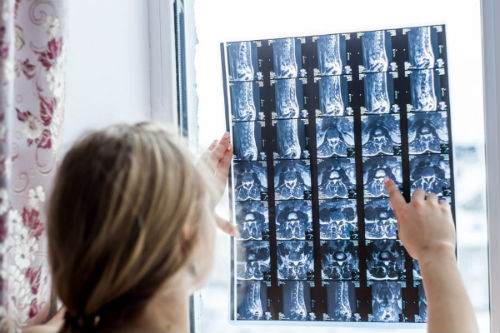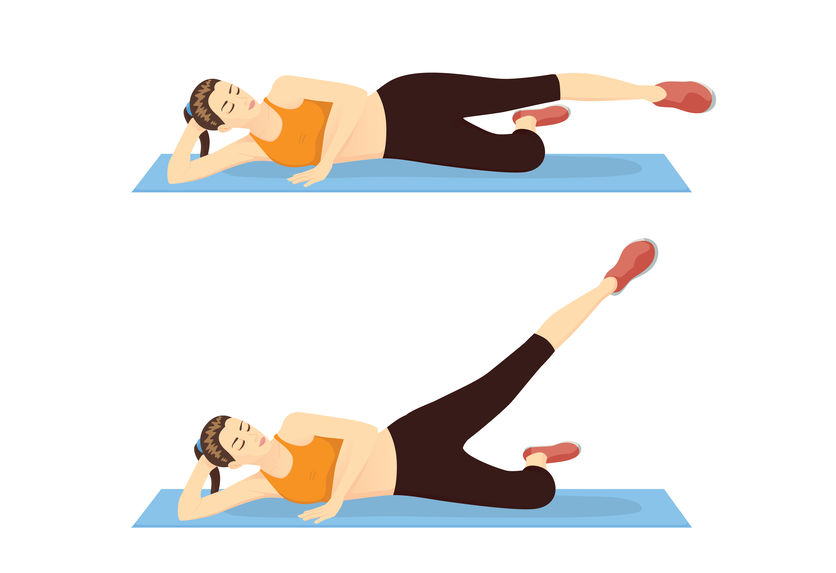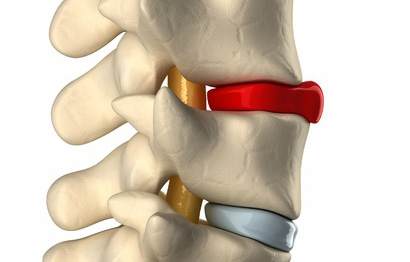Sacroiliac Joint Pain: 6 Exercises for Relief
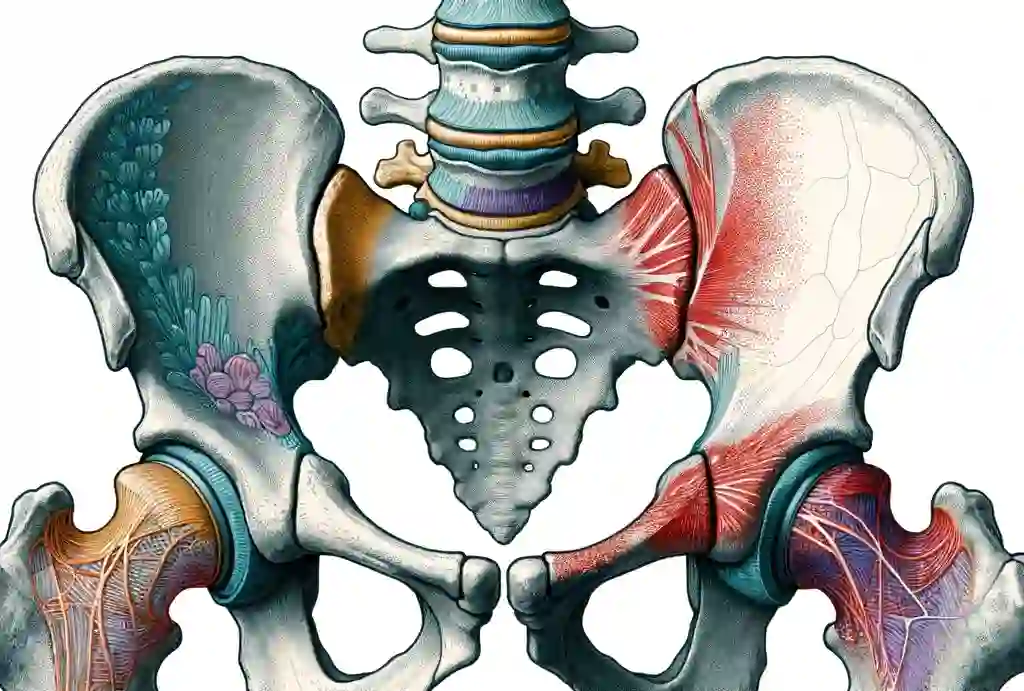
Do you have pain on one side of your lower back or upper buttock when rolling over in bed?
Do you have trouble sitting for long periods or when rising after sitting?
Is it painful when getting in or out of the car?
If you answered yes to any of these, you may have sacroiliac joint pain. Some experts call this condition sacroiliac joint dysfunction, sacroiliac joint strain and sometimes sacroiliac joint inflammation. Today I will go over sacroiliac joint dysfunction, and the causes of this condition and at the end will go over the exercises you need to get better.
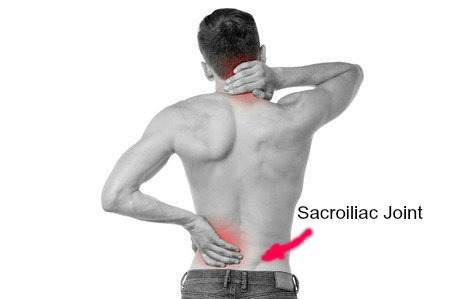
Sacroiliac joint pain for most of you will be on either side of the mid-line at the dimple in your lower back like the picture above. Some of you will have pain a little lower into the upper buttock. Sometimes the sacroiliac refers to pain down the back of the leg to the knee, and other times to the front of the thigh just at the crease that leads to the groin.
What Is Your Sacroiliac Joint?
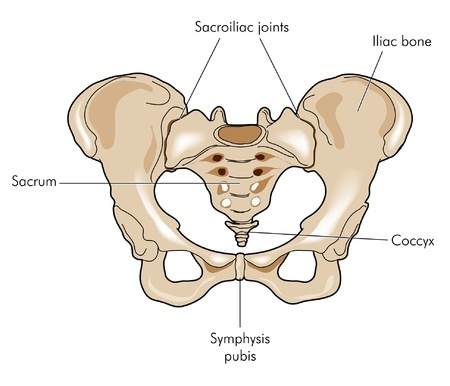
Your sacroiliac joints are the meeting of three bones together. Two iliac bones join together with the sacrum in the centre. As shown in the picture above.
You have these sacroiliac joints so that the joints distribute the forces from your legs up into your lower back. Your sacroiliac joints act like shock absorbers. A small amount of movement ranging from 2-17 degrees, [1-3] allows it to dampen some of the forces that come up into the pelvis.
The sacroiliac joints or SIJs also help to decrease the stress on the lumbar discs, especially at L5S1 [5]. Your L5 S1 disc is the disc found between the last vertebra and the sacrum.
Sacroiliac Joint Dysfunction is a painful condition caused by the irritation of your sacroiliac joint.
What’s The Cause Of Your Sacroiliac Joint Pain
One of the main causes is your habits. Crossing one leg over the other while sitting, and sitting with one leg tucked underneath your body while you are sitting.
Both of these habits have one thing in common. You are stretching the ligaments that protect the sacroiliac joint. If you do this once it will have no effect. Do this every day for hours and over many years you will have stretched the ligaments of the sacroiliac joint.
The ligaments become so stretched that you create an instability in your joint. This means that your sacroiliac joint is moving too much and causing irritation to the nerves that go to the joint. You get pain and referred pain when this happens.
Your sacroiliac joint can become painful for other reasons.
See Also: Posture Correct the Exaggerated Posture In Your Lower Back
Osteoarthritis or wear and tear of the cartilage of your sacroiliac joint. Your sacroiliac joint like other joints in the body is the meeting of two bones, your sacrum and your ilium. On either side of the bones where they join the bones are each covered in cartilage. The natural ageing or unnatural stresses on the joint wear the cartilage out.
While this is common many radiologists will attribute your pain to this. You have to be very careful. There is no correlation between sacroiliac dysfunction and the pain that you feel and MRI, CAT (CT) and X-rays results. [4]
This means you can have sacroiliac dysfunction with no osteoarthritis with an MRI, while osteoarthritis in the sacroiliac joint does not mean you have sacroiliac dysfunction. Most of the time you have no pain.

Pregnancy will make your ligaments looser. The later the stage of pregnancy the more hormone relaxin your body will make to get you ready for giving birth. The whole purpose of the relaxin hormone is to make your ligaments loose enough so that the baby’s head can pass through the bones of the pelvis. If you look at the picture above the baby’s head has to pass through the large hole in the pelvis. [5]
Short Leg: When you have one leg shorter than the other it puts the body off balance. More weight is usually put on your long leg putting more pressure through the hip and into your sacroiliac on that side. Sometimes the body compensates differently and you get pain on the sacroiliac joint on the short leg side.[6]
Arthritis such as gout, ankylosing spondylitis, rheumatoid arthritis and psoriasis all cause inflammation in the joint. This is very painful and usually hot right at the dimple and lower down. If the arthritis continues your sacroiliac will fuse and give you no pain.
Arthritis isn’t technically sacroiliac joint dysfunction but it is a cause of sacroiliac joint dysfunction.
Be Careful Of Your Diagnosis
Some reputable websites claim you can diagnose sacroiliac joint dysfunction based on MRI, CAT scans (CT) and X-rays. This is simply false! [7] First, these tests often find nothing wrong with the sacroiliac. Even if there is some osteoarthritis in the sacroiliac joint, this does not mean that the pain is coming from the sacroiliac joint.
As an example many people in their 60s will have osteoarthritis in their sacroiliac joints and many other places. Are all these other areas of osteoarthritis causing pain or just the sacroiliac osteoarthritis? The fact is people with no symptoms whatsoever have osteoarthritis in their sacroiliac joints.
Keep Your Doctor Honest
What you have to do is remember to make sure your doctor doesn’t diagnose and treat your X-ray or MRI. Treating what you see on MRI that isn’t causing your pain won’t get you anywhere.
Make sure your doctor does a thorough history and examination. You don’t need an X-ray, CAT scan or MRI unless you fit into the criteria in this article in the link below: In fact, for sacroiliac joint dysfunction, you should rarely get an X-ray.
See Also: MRI CT Scans and X-rays: Which One is Best For My Pain?
Hypermobility or Hypobility
The problem with sacroiliac joint dysfunction is that there is hypermobility which is too much movement or hypomobility which is too little movement. This is where a good chiropractor helps.
While there are good physiotherapists that manipulate chiropractors have far more training in manipulation, and practice it a lot more. As a general rule, I would go to the person who has the training but also keeps up with the skill every day.
Medical Treatment And Diagnosis
Many medical websites promote injections for diagnosis. The technique involves the injection of a pain-numbing medication like lidocaine using a live X-ray and sometimes with a radioactive dye to determine the area.
I think this works but I think it’s quite an intervention for this type of pain. From my point of view, it is better to have a less invasive procedure like manipulation.
Chiropractic Treatment and Diagnosis
Manipulation of the sacroiliac joint often will give immediate relief of sacroiliac joint dysfunction. By doing a trial of manipulation and exercises you can get a less invasive procedure, which costs less and is quite effective. Some websites have said that chiropractic for sacroiliac joint dysfunction is temporary but I have not found this to be true.
On the contrary, I have found with manipulation and proper exercises I have found that most people respond well within 6 visits. Please keep in mind that many chiropractors will not give you the exercises to help the problem for various reasons mostly related to the education they received. The chiropractors who have recently graduated tend to give more exercises while the ones who graduated many years ago do not give many exercises.
Note: I have to draw on my own experiences as there is limited research on sacroiliac joint dysfunction.
Sacroiliac Joint Belt
The sacroiliac joint belt is useful when things are acute and very painful. While it is very helpful at limiting the movement in the sacroiliac joint, you can become dependent on the belt and not build up the stability needed to get you better.
The sacroiliac belt should only be used as a temporary measure to get you out of the most acute pain. For most of you with pain that is bearable, I do not recommend a sacroiliac belt.
Exercises For Sacroiliac Joint Dysfunction: For Hypermobility (Instability)
The next three exercises are for a sacroiliac joint that is hypermobile (joint moving too much) if you have a hypermobile (joint not moving enough) joint it will not hurt to do these exercises as well.
Single Knee Out
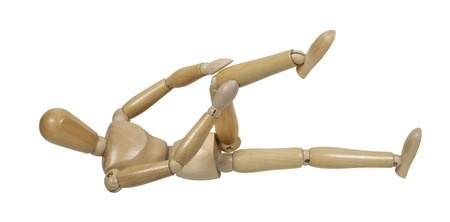
- While lying down on your back bring one knee toward the chest a little past 90 degrees.
- Hold onto the knee with both hands
- Push out toward your feet.
- Hold for 10 seconds. Repeat 5 times.
Ball Squeeze
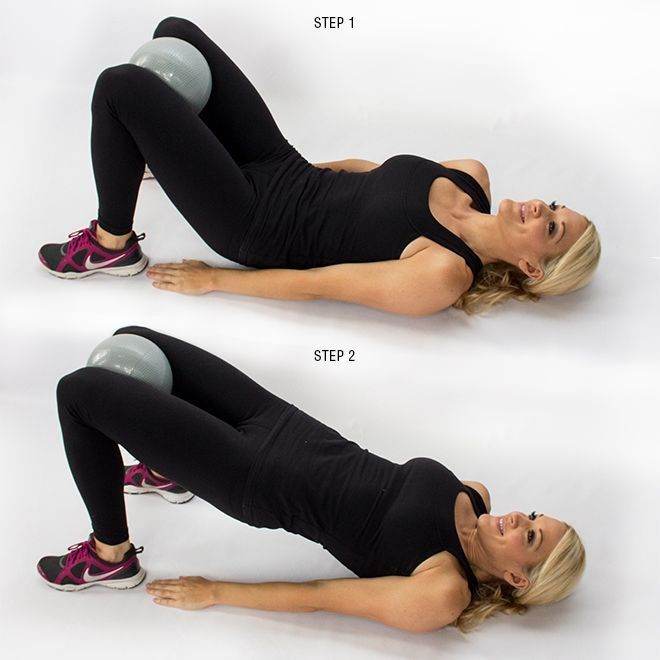
- Lie on your back with your knees bent.
- Take a ball and put it between your knees.
- Squeeze the ball for 10 seconds. Repeat 5 times.
- You can add step 2 to strengthen your abs and glutes. You do this by raising your torso and holding for 10 seconds. Repeat 5 times.
Theraband For Sacroiliac Pain
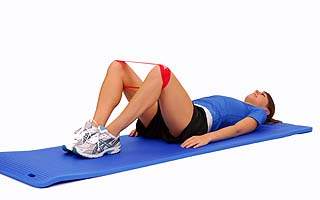
http://www.thera-bandacademy.com/
- Lie on your back with your knees bent.
- Push knees outward against the band, keeping feet together.
- Hold for 10 seconds and slowly return. Repeat 5 times
Exercises For Sacroiliac Joint Dysfunction: For Hypomobility (Not enough movement)
These exercises are for people who have a hypermobile joint. These exercises are designed to stretch the muscles that are holding the sacroiliac joint.
Warning: If you have hypermobility these exercises below will give you temporary relief but only serve to perpetuate your problem. In other words, you will get pain relief but continue to make your problems worse in the long run. One sign that you have a hypermobile joint that is moving too much is if your sacroiliac joint clicks all the time in that area. If you are not sure where the clicking is coming from or if you are unsure if you have a hypermobile joint you should not do these exercises.
#1 Piriformis Stretch: Seated
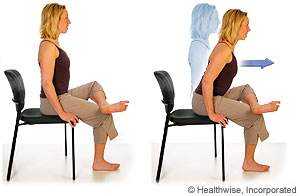
https://myhealth.alberta.ca/health/AfterCareInformation/pages/conditions.aspx?hwid=zp4551
- Sit in a sturdy chair.
- Cross your affected leg over your knee, resting your foot on top of your knee.
- Keep your back straight, and slowly lean forward until you feel a stretch in your hip.
- Hold for 30 seconds.
#2 Piriformis Stretch: Laying Down
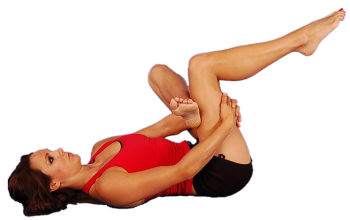
- Lay down on your back.
- Cross the affected leg over the other bent leg.
- Pull the unaffected leg towards you until you feel the stretch.
- Hold for 30 seconds 3 times.
#3 Stretch Your Hip Stabilizer: Gluteus Medius – Pigeon Pose

- Start on all fours like a crawl position.
- Bring your right leg forward and bend with the other leg straight back.
- Reach out forward with your body till you feel it in your hips.
Do this for 30 seconds 3 times.
Tell us what you think in the comments below and like us on Facebook. I will answer all questions in the comments section here at this downtown Toronto Chiropractic clinic.
Research
- Smidt, GL; et al (1995). “Sacroiliac kinematics for reciprocal straddle positions”. Spine 20 (9): 1047–1054. doi:10.1097/00007632-199505000-00011. PMID 7631234.
- Jump up^Smidt, GL; et al (1997). “Sacroiliac motion for extreme hip positions: A fresh cadaver study”. Spine 22 (18): 2073–2082. doi:10.1097/00007632-199709150-00003.PMID 9322317.
- Jump up^Sturesson, et al (2000). “A radio stereometric analysis of movements of the sacroiliac joints during the standing hip flexion test”. Spine 25 (3): 364–368. doi:10.1097/00007632-200002010-00018. PMID 10703111.
- http://en.wikipedia.org/wiki/Sacroiliac_joint_dysfunction.
- MacLennan, AH; MacLenna, SC (1997). “Symptom-giving Pelvic Girdle Relaxation of Pregnancy, Postnatal Pelvic Joint Syndrome and Developmental Dysplasia of Hip”.Acta Obstet Gynecol Scand 76 (8): 760–764.
- Richard L DonTigny, Anterior Dysfunction of the Sacroiliac Joint as a Pain Syndrome Major Factor in the Etiology of Idiopathic Low Back, PHYS THER. 1990; 70:250-262.
- Sims, Vicki, PT (2004). The Secret Cause of Low Back Pain: How to End Your Suffering. Georgia: sipress. pp. 11–12.



